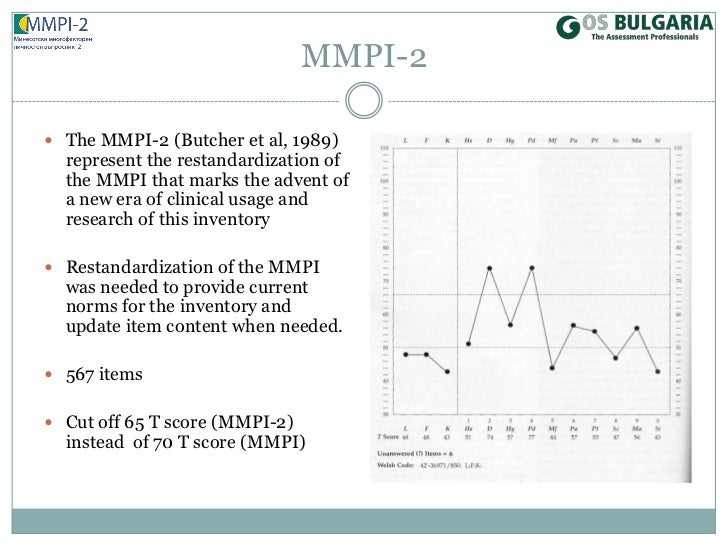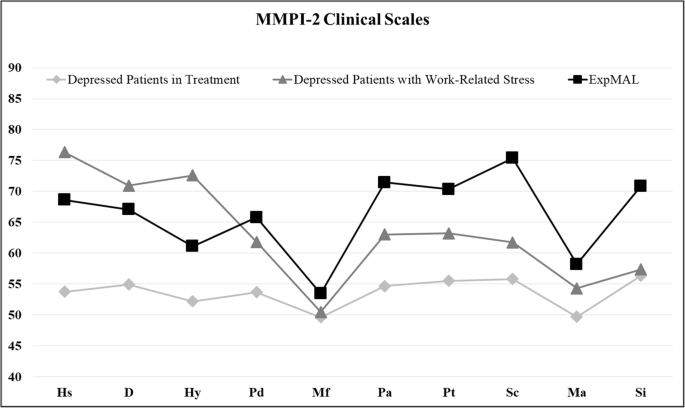

An interesting feature of the MMPI-2 is that over 300 “new” or experiential scales have been developed for the test over the years. A T-score of 65 or greater indicates clinically significant psychopathology on the MMPI-2. MMPI raw scores are transformed into standardized T-scores where the mean is 50 and the SD is 10. 9 The MMPI-2 contains 10 clinical scales that assess major categories of psychopathology and six validity scales designed to assess test-taking attitudes. 8 As mentioned earlier, the MMPI was designed to both separate subjects into “normals” and “abnormals,” and to subcategorize the abnormal group into specific classes.

The Minnesota Multiphasic Personality Inventory–2 (MMPI-2) is a 567-item true/false, self-report test of psychological function. Stern MD, in Massachusetts General Hospital Comprehensive Clinical Psychiatry, 2016 The Minnesota Multiphasic Personality Inventory–2 Computerized scoring and interpretations are also available and will be discussed latter in this chapter. For the MMPI-2 five of these raw scores (Hs, Pd, Pt, Sc, Ma) are corrected for defensiveness before the profile is drawn. The obtained raw scores are used then for plotting individual profiles.


#How to score the mmpi 2 by hand manual
Hand-scoring templates are available for manual scoring of the MMPI-2 and MMPI-A. Short forms (that is, forms that estimate scale scores from a reduced-item set) of the instrument are not appropriate alternatives to the standard MMPI ( Butcher, Kendall, & Hoffman, 1980 Dahlstrom, 1980) and are not recommended for clinical use ( Greene, 1991 Hart, McNeill, Lutz, & Adkins, 1986 Graham, 1993). The abbreviated form generates information on the standard validity and clinical indicators included in the first 370 items in the MMPI-2 booklet or the first 350 items in the MMPI-A booklet.
#How to score the mmpi 2 by hand full
If the subject is not able to complete the full test, an abbreviated version of MMPI-2/MMPI-A can be administered. Like most objective assessments, administration of the MMPI-2 and MMPI-A require standard procedures matching those employed in collecting normative data. In addition to the paper and pencil forms, audio-cassette or computer-automated administration is also available. A 5th- or 6th-grade level of reading is sufficient for comprehension of the items ( Butcher, 1995a). The MMPI-2 and MMPI-A are relatively easy to administer it takes only about 90 minutes to complete the MMPI-2 and 60 minutes for the MMPI-A. Butcher, in Handbook of Psychological Assessment (Third Edition), 2000 Administration and Scoring In this review, we aim to address this important issue and enhance our current understanding of the different MMPI patterns and dissemination tracks in the brain, liver and lung.Įlahe Nezami, James N. In spite of their relevance, MMPIs and organ-specific dissemination tracks are still largely overlooked by many clinicians, pathologists and/or researchers. Additionally, macro-metastases are a source of further tumor cell dissemination in the affected organ and these intra-organ metastatic dissemination tracks starting from the MMPI also vary depending on the anatomical structures of the colonized organ and influence disease outcome. The MMPI patterns could be further classified into three major groups: displacing, epithelial and diffuse infiltrating. Strikingly, the MMPI patterns differed between entities, so that at least nine different patterns were described. Recently, infiltrative growth of macro-metastases from various primary tumors was described in the brain, liver and lung, with significant impact on survival. The macro-metastasis/organ parenchyma interface (MMPI) was previously considered an inert anatomical border which sharply separates the affected organ parenchyma from the macro-metastatic tissue. Ira Skvortsova, in Seminars in Cancer Biology, 2019 Abstract


 0 kommentar(er)
0 kommentar(er)
